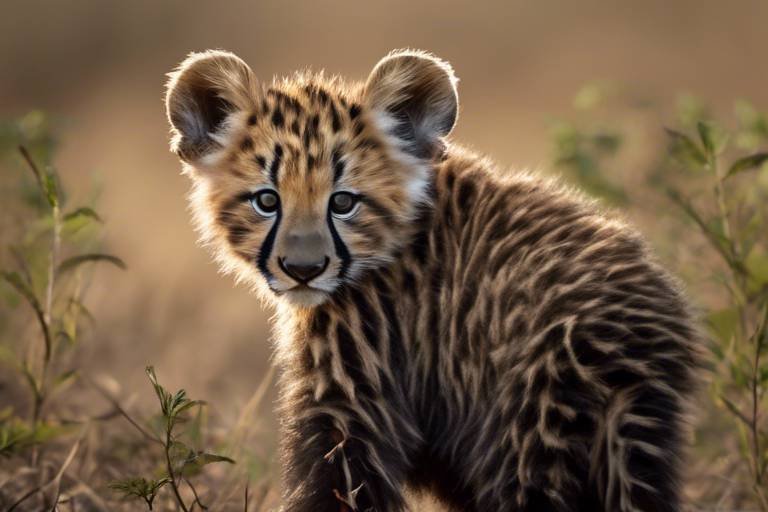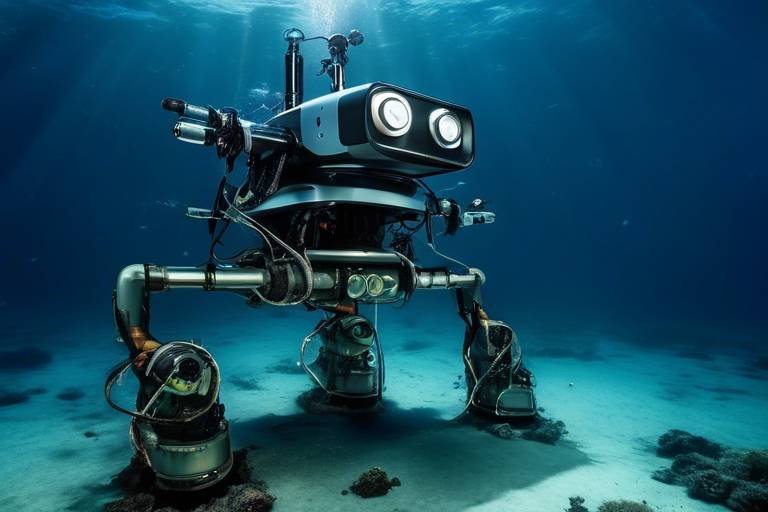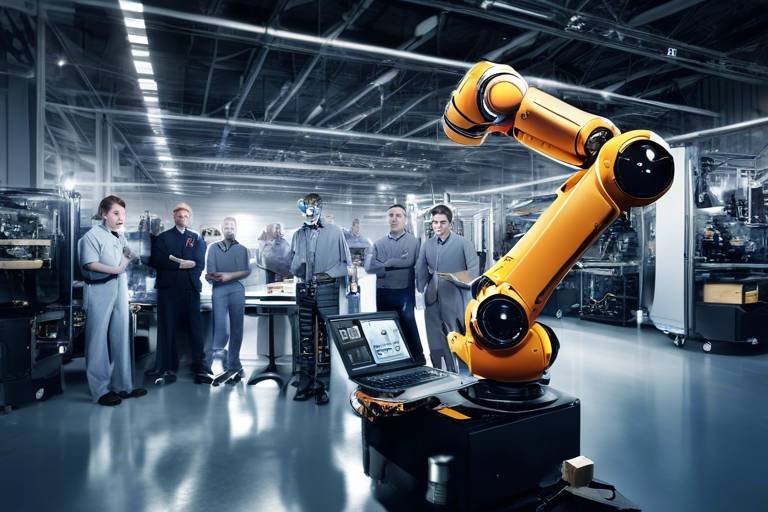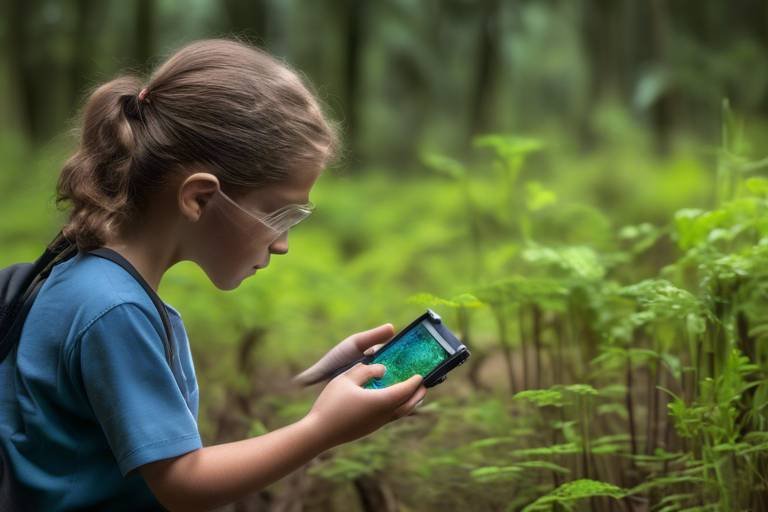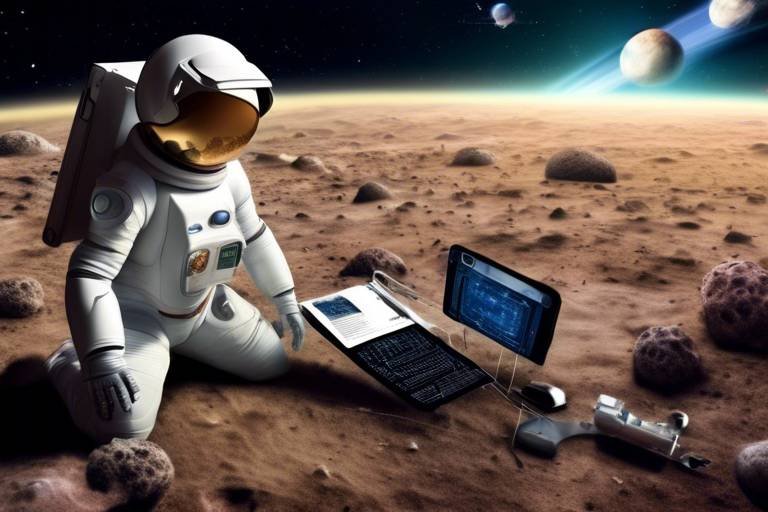How Technology is Enhancing Wildlife Conservation Efforts
In a world where wildlife faces unprecedented threats from habitat destruction, climate change, and poaching, the emergence of technology has become a beacon of hope for conservationists. Imagine a realm where drones soar high above dense forests, capturing images that reveal the hidden movements of endangered species, or where artificial intelligence analyzes vast datasets to predict the next big threat to wildlife. This is not science fiction; it’s the reality of modern wildlife conservation. With innovative tools and techniques at their disposal, conservationists are now more equipped than ever to tackle the challenges that threaten our planet's biodiversity.
As we delve deeper into the ways technology is revolutionizing wildlife conservation, we’ll uncover the various methods employed to monitor and protect our planet's most vulnerable species. From remote sensing that provides critical data on habitat changes to GPS tracking that reveals the secret lives of animals, technology is reshaping how we understand and interact with nature. It’s like having a superpower that allows us to see the unseen, understand the unknown, and act decisively to protect what we cherish.
Moreover, the integration of artificial intelligence into conservation strategies is akin to having a highly skilled analyst working around the clock, processing information and offering insights that were previously unattainable. This technological advancement not only enhances data collection but also streamlines the decision-making process, making conservation efforts more effective and efficient. With the help of technology, we are not just passive observers of wildlife; we are active participants in their survival.
In this article, we will explore the various dimensions of how technology is enhancing wildlife conservation efforts, including remote sensing, GPS tracking, artificial intelligence, and habitat restoration projects. We will also touch upon the ethical considerations that come with these advancements and the importance of community involvement through citizen science initiatives. So, buckle up as we embark on this fascinating journey into the intersection of technology and wildlife conservation!
- What role does technology play in wildlife conservation? Technology aids in data collection, monitoring animal behavior, and predicting potential threats, ultimately enhancing conservation strategies.
- How do GPS tracking devices help in conservation? GPS tracking provides real-time data on animal movements, which is crucial for understanding their behavior and habitat use.
- What are the ethical concerns regarding collaring animals? While collaring can provide valuable data, it raises questions about animal welfare and the potential stress caused by the devices.
- How can citizens contribute to wildlife conservation? Citizen science initiatives allow the public to participate in data collection and monitoring, fostering a sense of stewardship for wildlife.
- What is the impact of artificial intelligence on conservation? AI enhances data analysis and automates processes, enabling conservationists to focus on strategic decision-making and proactive measures.

Remote Sensing and Monitoring
In the ever-evolving field of wildlife conservation, technologies are proving to be game-changers. Imagine being able to observe vast stretches of wilderness without ever stepping foot in them! This is the power of satellite imagery and drones, which allow conservationists to gather critical data about wildlife populations and habitat changes from a bird’s-eye view. These technologies enable researchers to monitor areas that are otherwise inaccessible, providing insights that are crucial for making informed decisions.
Consider the implications: with remote sensing, conservationists can detect changes in land use, track deforestation, and even monitor the health of ecosystems over time. For instance, satellite data can reveal shifts in vegetation cover, while drones can capture high-resolution images that help in assessing the conditions of specific habitats. This information is invaluable for implementing timely interventions, ensuring that endangered species are protected before it's too late.
Moreover, remote sensing is not just about observation; it's about creating actionable strategies. By analyzing the data collected through these technologies, conservationists can identify trends and patterns that inform their efforts. For example, if a particular area shows a decline in wildlife populations, targeted conservation measures can be put in place, such as habitat restoration or anti-poaching initiatives. The ability to act swiftly based on reliable data can mean the difference between survival and extinction for many species.
To illustrate the impact of remote sensing, let’s take a look at a few key technologies and their applications:
| Technology | Application | Benefits |
|---|---|---|
| Satellite Imagery | Monitoring land use changes | Wide coverage and long-term data |
| Drones | High-resolution habitat assessment | Access to difficult terrains |
| LiDAR (Light Detection and Ranging) | Mapping forest structure | Precise topographical data |
In conclusion, remote sensing and monitoring technologies are revolutionizing the way we approach wildlife conservation. They not only enhance our understanding of ecosystems but also empower conservationists with the tools they need to make a real difference. As we continue to innovate and integrate these technologies into our conservation strategies, the potential for protecting endangered species and preserving their habitats becomes increasingly promising.

GPS Tracking for Wildlife
Imagine being able to follow a majestic elephant as it roams the savannah, or tracking the migration of a delicate monarch butterfly across thousands of miles. GPS tracking technology has made this dream a reality, transforming wildlife research and conservation efforts. By equipping animals with GPS devices, researchers can monitor their movements in real-time, gaining invaluable insights into their behavior, migration patterns, and habitat use. This information is not just fascinating; it is essential for developing effective conservation strategies that can adapt to the ever-changing challenges faced by wildlife.
One of the most significant advantages of GPS tracking is its ability to provide precise data on how animals interact with their environment. For instance, researchers can analyze the routes taken by animals, identify critical habitats, and understand how they respond to various environmental factors. This data can inform conservationists about the best practices for protecting endangered species and their habitats. With the world facing unprecedented biodiversity loss, the role of GPS tracking in conservation has never been more crucial.
To harness the power of GPS tracking, scientists often use collaring techniques. By fitting animals with collars embedded with GPS technology, researchers can collect continuous data on their movements and behaviors. This method is particularly effective for large mammals, such as bears, wolves, and elephants, where understanding territorial ranges and social interactions is vital. The data gathered can help identify migration corridors, breeding grounds, and areas of human-wildlife conflict, ultimately guiding conservation efforts.
However, the use of collars is not without its controversies. While these devices provide critical data, they also raise ethical questions regarding animal welfare. Some critics argue that the collars can cause stress or discomfort to the animals, potentially affecting their natural behaviors. It's essential for researchers to adhere to strict ethical guidelines and best practices when implementing GPS tracking to ensure that the welfare of the animals is prioritized. This includes using lightweight collars, monitoring the animals closely, and removing collars when they are no longer needed.
The data collected from GPS tracking is only as valuable as the analysis that follows. Skilled data scientists play a crucial role in interpreting the information gathered from these devices. They utilize advanced statistical methods and software to analyze patterns in the data, helping conservationists make informed decisions. The insights derived from GPS tracking can lead to targeted conservation efforts, ensuring that resources are allocated efficiently to areas where they will have the most significant impact.
In conclusion, GPS tracking is revolutionizing wildlife conservation by providing unprecedented access to data about animal movements and behaviors. As technology continues to advance, the potential for GPS tracking to enhance our understanding of wildlife is limitless. By combining this technology with ethical practices and skilled data analysis, we can pave the way for more effective conservation strategies that protect our planet's precious biodiversity.
- How does GPS tracking work for wildlife? GPS tracking works by using satellites to determine the precise location of animals fitted with GPS collars, allowing researchers to monitor their movements.
- Are there any risks associated with collaring animals? Yes, collaring can pose risks such as stress or injury to the animals, which is why ethical guidelines must be followed.
- What types of animals can be tracked using GPS? A wide variety of animals can be tracked using GPS, including mammals, birds, reptiles, and even marine life.
- How is the data from GPS tracking used in conservation? The data is analyzed to understand animal behavior, identify critical habitats, and inform conservation strategies to protect endangered species.

Collaring Techniques
Collaring techniques have emerged as a pivotal strategy in wildlife conservation, enabling researchers to gather essential data about animal behavior and their interactions with the environment. By fitting animals with GPS collars, conservationists can track movements, monitor health, and understand habitat utilization in a way that was previously unimaginable. Imagine being able to follow the journeys of endangered species in real-time—this is the power of modern technology!
These collars come equipped with various sensors that not only track location but also monitor physiological parameters such as heart rate and body temperature. This multifaceted approach allows researchers to develop a comprehensive understanding of the species they are studying. For instance, have been instrumental in uncovering migration patterns, breeding habits, and even social dynamics within animal groups. The data collected from these collars can be analyzed to identify critical habitats that need protection or to predict potential conflicts between wildlife and human activities.
However, it’s essential to consider the implications of collaring animals. While the benefits are significant, there are ethical concerns regarding the potential stress these devices may cause. Conservationists must adhere to strict guidelines to minimize any discomfort experienced by the animals. This includes using lightweight materials, ensuring proper fit, and regularly monitoring the animals to assess their well-being. The balance between collecting valuable data and ensuring animal welfare is a delicate one, but it is crucial for the success of conservation efforts.
Moreover, the data obtained from collaring techniques is not just numbers and statistics; it tells a story about the lives of these animals and their habitats. For example, researchers can identify hotspots for poaching and implement protective measures in those areas. By understanding how animals interact with their environment, conservationists can develop tailored strategies that address specific challenges faced by different species.
In summary, collaring techniques represent a significant advancement in wildlife conservation. They provide invaluable insights that help shape effective conservation strategies, ensuring that we can protect endangered species and their habitats. As technology continues to evolve, so too will the methods we use to safeguard the future of our planet's wildlife.
- What are the main benefits of using collaring techniques in wildlife conservation?
Collaring techniques provide real-time data on animal movements, health, and habitat use, which are crucial for developing effective conservation strategies.
- Are there any ethical concerns associated with collaring animals?
Yes, while collaring can provide valuable data, it raises ethical questions regarding animal welfare and the potential stress caused by the devices.
- How is the data from GPS collars analyzed?
The data collected from GPS collars is analyzed by skilled data scientists who interpret the information to inform conservation efforts.

Ethical Considerations
When it comes to wildlife conservation, the use of technology, particularly in the form of GPS collaring, brings about a myriad of that cannot be overlooked. While the benefits of tracking wildlife populations and gathering data on animal behavior are evident, we must also examine the potential impact on the animals themselves. Are we, in our quest to save endangered species, inadvertently causing them stress or discomfort? This is a question that conservationists grapple with as they weigh the pros and cons of technological interventions.
One of the primary concerns surrounding the use of GPS collars is the stress and anxiety that these devices may impose on animals. Imagine wearing a heavy backpack all day long; it could be uncomfortable and distracting, right? Similarly, animals fitted with collars may experience a range of stress responses, which can affect their health and behavior. Therefore, it’s crucial for researchers to ensure that the collars are designed with the utmost care, considering the size, weight, and fit for the specific species being studied.
Moreover, the ethical implications extend beyond the physical discomfort of the animals. There is a need for transparency in the research process. Conservationists must communicate their methods and findings clearly to the public and stakeholders. This transparency fosters trust and encourages community involvement, which is vital for the success of any conservation initiative. Engaging local communities can also help in understanding the cultural significance of certain species, thus enriching the conservation narrative.
To address these ethical concerns, many organizations are adopting a set of best practices, which include:
- Minimizing the duration of collaring procedures to reduce stress.
- Using non-invasive methods whenever possible.
- Regularly monitoring the health of collared animals.
- Involving local communities in the decision-making process.
In conclusion, while technology offers groundbreaking tools for wildlife conservation, it is imperative that we approach its use with a sense of responsibility and ethical awareness. By prioritizing the well-being of the animals and maintaining open lines of communication with the public, we can create a more effective and compassionate conservation strategy.
Q1: What are the main ethical concerns regarding GPS collaring in wildlife conservation?
A1: The main ethical concerns include the potential stress and discomfort caused to the animals, the need for transparency in research methods, and the importance of involving local communities in conservation efforts.
Q2: How can researchers minimize stress for collared animals?
A2: Researchers can minimize stress by ensuring that collaring procedures are quick, using lightweight and properly fitted collars, and regularly monitoring the health and behavior of the collared animals.
Q3: Why is community involvement important in wildlife conservation?
A3: Community involvement is crucial as it fosters trust, enhances local knowledge, and ensures that conservation efforts are culturally sensitive and more likely to succeed.

Data Analysis and Interpretation
In the realm of wildlife conservation, the significance of data analysis and interpretation cannot be understated. As conservationists gather vast amounts of data from various sources, including GPS tracking, camera traps, and remote sensing technologies, the ability to analyze and interpret this information becomes crucial. Imagine trying to solve a complex puzzle without knowing what the final picture looks like; that’s what conservationists face without effective data analysis. The insights derived from this data not only inform strategies but also guide the allocation of resources to areas where they are needed most.
To put it simply, data analysis in wildlife conservation serves several key purposes:
- Identifying Trends: By analyzing historical data, researchers can identify trends in wildlife populations, such as declines or recoveries, which can inform future conservation efforts.
- Understanding Behaviors: Interpretation of data allows scientists to understand animal behaviors, migration patterns, and habitat preferences, which are essential for creating effective conservation plans.
- Evaluating Effectiveness: Data analysis helps evaluate the effectiveness of current conservation strategies, providing evidence for what works and what needs adjustment.
However, the process is not as simple as it sounds. The data collected can be complex and multifaceted, often requiring advanced statistical methods and software to analyze. This is where the role of skilled data scientists comes into play. These professionals are trained to sift through the noise, extract meaningful insights, and present them in a way that is actionable for conservationists. They utilize various tools and techniques, such as machine learning algorithms and data visualization software, to transform raw data into understandable formats.
For instance, consider a scenario where researchers are monitoring a population of endangered elephants. They collect data on their movements, health, and interactions with their environment. A data scientist might use this information to create visual maps that highlight areas of high activity, identify potential threats, and suggest conservation actions. The outcome? More targeted and efficient conservation efforts that can lead to better protection of these magnificent creatures.
Moreover, collaboration among various stakeholders enhances the data analysis process. Conservation organizations, academic institutions, and government agencies can share data and insights, leading to a more comprehensive understanding of wildlife dynamics. This collaborative approach not only enriches the data pool but also fosters innovative solutions to pressing conservation challenges.
In conclusion, data analysis and interpretation are the backbone of effective wildlife conservation. By leveraging technology and skilled professionals, conservationists can make informed decisions that ultimately enhance the survival prospects of endangered species. As we continue to harness the power of data, the future of wildlife conservation looks promising, paving the way for sustainable coexistence between humans and nature.
- What is the role of technology in wildlife conservation?
Technology enhances wildlife conservation by providing tools for monitoring, data collection, and analysis, leading to more effective strategies for protecting endangered species. - How does GPS tracking help in conservation?
GPS tracking allows researchers to monitor animal movements in real-time, offering insights into their behavior and habitat use, which is crucial for developing conservation plans. - Why is data analysis important in conservation?
Data analysis helps identify trends, understand animal behaviors, and evaluate conservation strategies, ensuring that efforts are targeted and effective.

Citizen Science Initiatives
Citizen science initiatives have become a powerful tool in the realm of wildlife conservation, effectively bridging the gap between researchers and the public. By engaging everyday people in scientific research, these initiatives not only enhance data collection but also foster a profound sense of stewardship among community members. Imagine a world where your weekend hike could contribute to the understanding of local wildlife populations. This is the reality that citizen science creates, turning ordinary citizens into valuable contributors to conservation efforts.
One of the most significant aspects of citizen science is its ability to amplify the reach of conservation projects. Volunteers from various backgrounds can participate in activities such as bird watching, wildlife surveys, and habitat assessments. This not only increases the volume of data collected but also introduces diverse perspectives that can enrich the research process. For instance, local volunteers often possess intimate knowledge of their surroundings, which can lead to discoveries that might otherwise go unnoticed by professional scientists.
Moreover, citizen science projects often utilize technology to streamline data collection. Many initiatives employ mobile applications that allow participants to record their observations in real-time. This technology not only makes it easier for volunteers to contribute but also ensures that the data is accurate and readily available for analysis. For example, platforms like iNaturalist allow users to upload photos of wildlife, which are then identified by a community of experts and enthusiasts. The data collected through such platforms can be invaluable for tracking species distribution and monitoring population changes.
In addition to enhancing data collection, citizen science initiatives play a crucial role in raising awareness about conservation issues. When individuals become actively involved in monitoring wildlife, they develop a deeper understanding of the challenges that these species face. This heightened awareness often translates into advocacy, with participants becoming vocal supporters of conservation policies and practices.
Overall, citizen science initiatives represent a vibrant intersection of community engagement and scientific research. They harness the enthusiasm and unique insights of volunteers, creating a collaborative approach to wildlife conservation that is both innovative and effective. By empowering individuals to take part in these initiatives, we not only broaden our understanding of wildlife but also cultivate a collective responsibility for the natural world.
-
What is citizen science?
Citizen science is a collaborative effort where volunteers contribute to scientific research, often by collecting data or monitoring wildlife in their local areas.
-
How can I get involved in citizen science initiatives?
You can participate in various projects through online platforms, local conservation groups, or community events focused on wildlife monitoring and data collection.
-
What are the benefits of citizen science?
Citizen science enhances data collection, raises awareness about conservation issues, and fosters community engagement, ultimately contributing to more effective wildlife conservation efforts.

Artificial Intelligence in Conservation
Artificial intelligence (AI) is not just a buzzword; it’s a game-changer in the realm of wildlife conservation. Imagine having the ability to analyze vast amounts of data in the blink of an eye, predicting trends, and automating processes that once took human researchers countless hours. With AI, conservationists can now focus on what truly matters: making strategic decisions that protect our planet's most vulnerable species. This technology is revolutionizing the way we approach conservation, making efforts more effective and efficient.
One of the standout applications of AI in conservation is through the use of camera trap technology. These devices, equipped with AI algorithms, can automatically identify various species and count their populations. This is particularly beneficial in remote areas where human presence is limited. By eliminating the need for manual data analysis, AI-powered camera traps enhance wildlife monitoring significantly. For instance, they can distinguish between different animal species based on their size, shape, and movement patterns, providing researchers with accurate and timely data.
Moreover, AI's role extends beyond mere data collection. It plays a crucial part in predictive analytics. By analyzing historical data and current trends, AI can forecast potential threats to wildlife, such as poaching or habitat loss. This foresight enables conservationists to take proactive measures before these threats escalate. For example, if AI identifies a rising trend in poaching incidents in a specific area, conservationists can allocate resources to increase patrols and surveillance in that region. This ability to predict and respond swiftly is invaluable in the fight against wildlife crime.
To illustrate the impact of AI in conservation, consider the following table that summarizes some key benefits:
| AI Application | Benefit |
|---|---|
| Camera Trap Technology | Automated species identification and population counting |
| Predictive Analytics | Forecasting threats and enabling proactive measures |
| Data Management | Efficient handling of large datasets for informed decision-making |
| Behavioral Analysis | Understanding animal behavior patterns for better conservation strategies |
While the integration of AI in conservation is promising, it is essential to remember that technology should complement, not replace, the human touch. The insights provided by AI need to be interpreted by skilled conservationists who can make ethical decisions based on the data. This collaboration between technology and human expertise ensures that wildlife conservation remains effective and compassionate.
In conclusion, the advent of artificial intelligence in wildlife conservation is akin to giving conservationists a superpower. With tools that enhance monitoring, predict threats, and streamline data management, we are better equipped to protect our planet’s biodiversity. As we continue to embrace these innovations, the future of wildlife conservation looks brighter than ever.
- How is AI used in wildlife conservation? AI is used for analyzing data, monitoring wildlife through camera traps, and predicting potential threats to species.
- What are camera traps? Camera traps are automated devices that capture images of wildlife, often used to monitor animal populations and behaviors.
- Can AI replace human conservationists? No, AI is a tool that enhances the work of conservationists but cannot replace the ethical considerations and expertise they provide.
- Why is predictive analytics important for conservation? Predictive analytics helps conservationists anticipate threats and take proactive measures to protect wildlife before issues arise.

Camera Trap Technology
In the realm of wildlife conservation, has emerged as a game-changer, revolutionizing the way we monitor and study wildlife populations. These ingenious devices, strategically placed in natural habitats, capture high-quality images and videos of animals in their natural behaviors without human interference. Imagine being able to observe a rare species in its daily routine, all while remaining completely invisible! This non-invasive method not only minimizes stress on the animals but also provides invaluable data that can significantly aid conservation efforts.
One of the most significant advantages of camera traps is their ability to operate in remote locations, where traditional observation methods may be impractical. Equipped with motion sensors, these cameras can detect movement and trigger recordings, allowing researchers to gather data over extended periods. This means that conservationists can monitor elusive species that are otherwise difficult to study. For instance, studies have shown that camera traps can help identify population sizes, track migration patterns, and even observe mating behaviors, offering a wealth of information that was previously out of reach.
Moreover, the integration of artificial intelligence into camera trap technology has further enhanced its capabilities. AI algorithms can process the vast amounts of data collected, automatically identifying species and counting individuals in the images. This not only speeds up the data collection process but also reduces human error. For example, a recent study utilizing AI-powered camera traps in a rainforest revealed the presence of several previously unrecorded species, showcasing the potential of this technology to uncover hidden biodiversity.
However, it's essential to recognize that while camera traps offer remarkable benefits, they also come with challenges. The sheer volume of data generated can be overwhelming, requiring skilled data scientists to analyze and interpret the findings effectively. Additionally, there are ethical considerations regarding the placement of these cameras, ensuring they do not disrupt the natural behaviors of the wildlife being observed. Striking a balance between gathering crucial data and maintaining the integrity of the ecosystem is paramount.
To summarize, camera trap technology is not just a tool; it is a powerful ally in the fight for wildlife conservation. By providing a window into the lives of animals, it equips conservationists with the knowledge needed to make informed decisions and implement effective strategies. As technology continues to evolve, the potential for camera traps to contribute to the understanding and preservation of our planet's biodiversity is boundless.
- What is a camera trap? A camera trap is a motion-activated camera used to capture images or videos of wildlife in their natural habitat.
- How does camera trap technology benefit wildlife conservation? It allows researchers to monitor animal populations and behaviors without disturbing them, providing crucial data for conservation efforts.
- Can camera traps identify different species? Yes, with the help of artificial intelligence, camera traps can automatically identify species and count individuals in the captured images.
- Are there any ethical concerns with using camera traps? Yes, careful consideration is needed to ensure that the placement of camera traps does not interfere with wildlife behavior or habitats.

Predictive Analytics
Predictive analytics is like having a crystal ball for wildlife conservation. By utilizing advanced algorithms and machine learning, conservationists can analyze vast amounts of data to forecast potential threats to wildlife populations. Imagine being able to predict a drought before it happens or understanding how a new development might impact a migratory route. This foresight is crucial in making informed decisions that can save species from the brink of extinction.
One of the most exciting aspects of predictive analytics is its ability to process data from various sources. For instance, data from GPS tracking, climate models, and even social media can be combined to create a comprehensive picture of the challenges facing wildlife. By identifying patterns and trends, conservationists can implement proactive measures to mitigate risks before they escalate. It's like being a detective, piecing together clues to solve a mystery before it unfolds.
Moreover, predictive analytics allows for the prioritization of conservation efforts. With limited resources, it's essential to know where to focus attention. By analyzing data, conservationists can identify which species or habitats are at the highest risk and allocate resources accordingly. This targeted approach not only increases efficiency but also enhances the likelihood of successful outcomes. For example, if data shows that a specific habitat is deteriorating rapidly, immediate action can be taken to restore it, benefiting both the ecosystem and the wildlife that depend on it.
To illustrate the impact of predictive analytics, consider the following table that highlights some key applications in wildlife conservation:
| Application | Description | Benefits |
|---|---|---|
| Threat Forecasting | Predicting environmental changes that could threaten habitats. | Allows for timely interventions to protect vulnerable species. |
| Population Dynamics | Analyzing trends in animal populations to predict future changes. | Helps in adjusting conservation strategies based on predicted outcomes. |
| Human-Wildlife Conflict | Identifying potential areas of conflict between humans and wildlife. | Facilitates proactive measures to minimize conflicts and protect wildlife. |
In conclusion, predictive analytics is revolutionizing wildlife conservation by turning data into actionable insights. It empowers conservationists to anticipate challenges and act before they become crises. As technology continues to evolve, the potential for predictive analytics to enhance conservation efforts will only grow, making it an indispensable tool in the fight to protect our planet's biodiversity.
- What is predictive analytics? Predictive analytics involves using statistical algorithms and machine learning techniques to identify the likelihood of future outcomes based on historical data.
- How does predictive analytics help wildlife conservation? It helps conservationists forecast potential threats, prioritize conservation efforts, and make informed decisions to protect endangered species and their habitats.
- Can predictive analytics be used for other fields? Yes, predictive analytics is widely used in various fields, including healthcare, finance, marketing, and environmental science.
- What types of data are used in predictive analytics for conservation? Data from GPS tracking, climate models, habitat assessments, and even social media can be utilized to create comprehensive predictive models.

Habitat Restoration Projects
Habitat restoration is not just a buzzword; it's a critical lifeline for our planet's diverse ecosystems. With the relentless march of urbanization, climate change, and pollution, many natural habitats have been severely degraded. This is where technology steps in, acting like a superhero in a world that desperately needs saving. By employing advanced techniques and tools, conservationists are now able to rehabilitate ecosystems more efficiently than ever before, ensuring a sustainable environment where wildlife can thrive.
One of the most exciting advancements in habitat restoration is the use of drones. These flying marvels are revolutionizing reforestation efforts. Imagine being able to plant thousands of trees in hard-to-reach areas that were once considered inaccessible! Drones can cover vast landscapes, dropping seeds with pinpoint precision. This method not only speeds up the reforestation process but also minimizes human labor and the associated costs. In fact, studies have shown that drone-assisted reforestation can be up to 10 times more efficient than traditional methods.
Moreover, the integration of technology doesn't stop there. Monitoring the health of restored habitats is equally important, and this is where soil and water quality monitoring comes into play. Technological advancements have made it possible to utilize sensors and remote monitoring systems to keep track of vital ecological indicators. For instance, soil moisture levels, pH balance, and nutrient content can now be assessed in real-time, providing conservationists with essential data to ensure that ecosystems remain healthy and resilient to environmental changes.
In addition to drones and monitoring systems, habitat restoration projects often involve community engagement. By involving local communities, we not only foster a sense of ownership but also leverage local knowledge about the ecosystem. This grassroots approach ensures that restoration efforts are tailored to the specific needs of the environment, making them more effective in the long run. When people feel connected to their environment, they are more likely to protect it, creating a powerful synergy between technology and human involvement.
In summary, habitat restoration projects are a vital component of wildlife conservation, and technology is enhancing these efforts in remarkable ways. From drone-assisted reforestation to advanced monitoring techniques, the tools available today empower conservationists to restore and protect our planet's precious ecosystems. As we move forward, it’s imperative that we continue to innovate and adapt, ensuring that our natural habitats not only survive but thrive for generations to come.
- What is habitat restoration?
Habitat restoration is the process of returning a degraded or destroyed ecosystem to its original state, making it suitable for wildlife and plants to thrive. - How do drones help in habitat restoration?
Drones can efficiently plant seeds in hard-to-reach areas, significantly speeding up the reforestation process and minimizing human labor. - Why is soil and water quality monitoring important?
Monitoring soil and water quality is crucial for ensuring that restored habitats remain healthy and resilient to environmental changes. - Can local communities contribute to restoration efforts?
Yes! Engaging local communities fosters a sense of stewardship and leverages local knowledge, making restoration efforts more effective.

Drone-Assisted Reforestation
In the quest to restore our planet's dwindling forests, has emerged as a groundbreaking solution. Imagine a world where reforestation efforts are not only faster but also more efficient, thanks to the power of technology. Drones equipped with advanced seed-planting mechanisms can cover vast areas of land in a fraction of the time it would take human workers. This innovative approach is revolutionizing how we think about reforestation, making it possible to restore ecosystems that have been damaged by deforestation, climate change, and human activity.
One of the most significant advantages of using drones for reforestation is their ability to reach hard-to-access areas. Traditional reforestation methods often involve labor-intensive processes, requiring workers to trek through difficult terrains. Drones, on the other hand, can effortlessly fly over rugged landscapes, dropping seeds precisely where they are needed. This not only saves time but also reduces the physical strain on workers, making the entire process more sustainable.
Moreover, the use of drones allows for highly targeted planting. With the help of GPS technology and aerial mapping, drones can identify the most suitable locations for seed dispersal based on environmental conditions. This precision ensures that seeds are planted in areas where they are most likely to thrive, ultimately increasing the success rate of reforestation efforts. For instance, a recent project in Madagascar utilized drones to plant over 1.5 million trees in just a few weeks, demonstrating the incredible potential of this technology.
However, the benefits of drone-assisted reforestation extend beyond mere efficiency. Drones can also be equipped with sensors to monitor the health of newly planted trees. By collecting data on soil moisture, temperature, and other environmental factors, conservationists can gain valuable insights into how well the reforestation efforts are progressing. This data-driven approach allows for timely interventions, ensuring that the young trees receive the care they need to grow strong and healthy.
As we look to the future, it’s clear that drone-assisted reforestation is not just a trend; it’s a game-changer in the fight against deforestation. By harnessing the power of technology, we can restore ecosystems, combat climate change, and create a more sustainable world for future generations. The integration of drones into reforestation strategies is a shining example of how innovation can lead to positive environmental outcomes.
- What is drone-assisted reforestation?
Drone-assisted reforestation involves using drones to plant seeds in deforested areas, making the process faster and more efficient. - How do drones improve reforestation efforts?
Drones can access hard-to-reach areas, provide targeted planting, and collect data on the health of newly planted trees. - Are there any limitations to using drones for reforestation?
While drones offer many advantages, they may not be suitable for all environments, and initial setup costs can be high. - Can drones help monitor the progress of reforestation?
Yes, drones equipped with sensors can monitor soil and environmental conditions, providing valuable data for conservationists.

Soil and Water Quality Monitoring
In the realm of wildlife conservation, maintaining healthy ecosystems is paramount, and that starts with understanding the quality of soil and water. Advanced technology has made it easier than ever to monitor these critical environmental factors, enabling conservationists to make informed decisions that directly impact wildlife habitats. Imagine trying to grow a garden without knowing the condition of your soil or the quality of your water—it's nearly impossible! Similarly, wildlife thrives in environments where soil and water quality are optimal, and technology is stepping in to ensure these conditions are met.
Modern monitoring techniques use a combination of sensors, drones, and data analytics to assess soil and water quality in real-time. For instance, soil sensors can measure moisture levels, pH, and nutrient content, while water quality sensors can detect pollutants, temperature changes, and oxygen levels. This data is crucial for understanding how different factors—like climate change or human activity—affect the ecosystems where wildlife resides.
One of the most significant advantages of these technologies is their ability to provide continuous data collection. Traditional methods often rely on periodic sampling, which can miss critical changes in environmental conditions. With the advent of real-time monitoring, conservationists can respond swiftly to any potential threats. For example, if a sudden spike in pollution levels is detected in a river, immediate action can be taken to mitigate the impact on aquatic life.
To illustrate the effectiveness of soil and water quality monitoring, consider the following table that outlines key parameters and their significance:
| Parameter | Importance |
|---|---|
| pH Level | Affects nutrient availability and microbial activity. |
| Nutrient Content | Essential for plant growth, which supports herbivores and predators. |
| Moisture Levels | Critical for plant survival and ecosystem balance. |
| Pollutant Levels | Indicates the health of aquatic ecosystems and potential threats to wildlife. |
Furthermore, the integration of machine learning algorithms with monitoring systems allows for predictive analytics, which can forecast potential environmental changes based on current data trends. This means that conservationists can anticipate issues before they become critical, preserving habitats and protecting vulnerable species. It's like having a crystal ball that shows not just the present but also potential futures!
As we move forward, the role of technology in soil and water quality monitoring will only expand. By harnessing these innovative tools, conservation efforts can be more targeted and effective, ensuring that wildlife not only survives but thrives in their natural habitats. The health of our planet's ecosystems is intertwined with the health of its wildlife, and monitoring soil and water quality is a vital step in safeguarding this balance.
- What technologies are used for soil and water quality monitoring?
Technologies include soil sensors, water quality sensors, drones, and data analytics platforms.
- How does real-time monitoring benefit wildlife conservation?
Real-time monitoring allows for immediate responses to environmental changes, helping to protect ecosystems and wildlife.
- Can soil and water quality monitoring predict future environmental changes?
Yes, by using machine learning and predictive analytics, conservationists can forecast potential threats based on current data trends.
Frequently Asked Questions
- How is technology being used in wildlife conservation?
Technology is revolutionizing wildlife conservation through various innovative methods. For instance, remote sensing and monitoring tools like satellite imagery and drones provide critical data for tracking wildlife populations and habitat changes. Additionally, GPS tracking devices allow researchers to monitor animal movements in real-time, offering insights into their behavior and migration patterns.
- What are the benefits of GPS tracking for wildlife?
GPS tracking offers a treasure trove of benefits for wildlife conservation. It helps researchers gather vital data on animal movements, enabling them to understand migration patterns and habitat use. This information is essential for developing effective conservation strategies tailored to the needs of specific species and their environments.
- Are there ethical concerns with collaring animals for research?
Yes, collaring animals with GPS devices does raise ethical questions regarding animal welfare. While the data collected is invaluable for conservation efforts, it’s crucial to consider the potential stress these devices may cause to the animals. Conservationists must adhere to best practices and ensure that the benefits of collaring outweigh any potential harm.
- How does artificial intelligence enhance wildlife conservation?
Artificial intelligence (AI) enhances wildlife conservation by analyzing large datasets, predicting trends, and automating processes. For example, AI-powered camera traps can automatically identify species and count populations, significantly improving data collection efficiency. This allows conservationists to focus on strategic decision-making and proactive measures to protect wildlife.
- What role do citizen science initiatives play in conservation?
Citizen science initiatives empower communities to engage in wildlife monitoring, fostering a sense of stewardship. By involving the public, these projects increase the volume of data available for conservation efforts, making it easier to track wildlife populations and their habitats. It’s a win-win situation where both the community and conservationists benefit!
- How are drones used in habitat restoration?
Drones are game changers in habitat restoration projects. They efficiently plant trees in hard-to-reach areas, which is crucial for restoring ecosystems and improving biodiversity. This technology not only speeds up the reforestation process but also ensures that restoration efforts are more effective and sustainable.
- Why is monitoring soil and water quality important for conservation?
Monitoring soil and water quality is vital for successful habitat restoration because healthy ecosystems depend on these factors. Technological advancements in monitoring allow conservationists to ensure that the environments where wildlife thrive remain resilient to changes, thus supporting ongoing conservation efforts and biodiversity.

